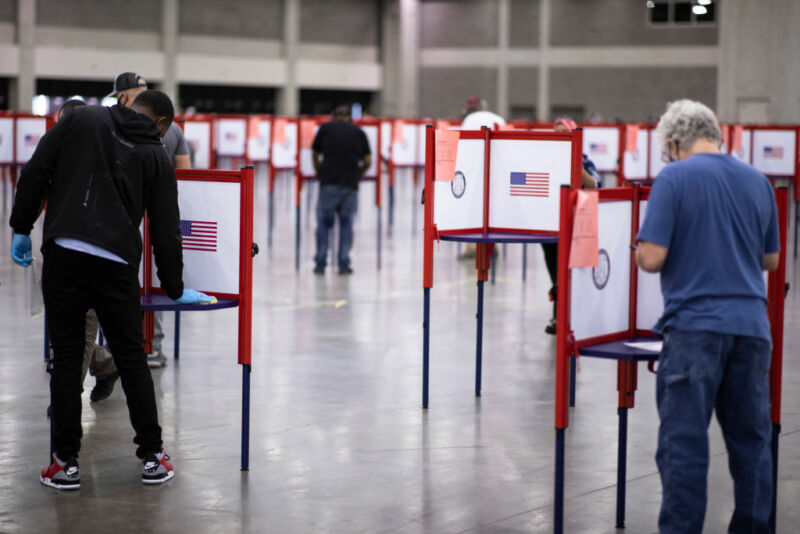Mailing it in —
A slight uptick in turnout, and no indication of either party gaining.
John Timmer
–

Enlarge / Socially distanced voting may not be needed if vote by mail is adopted.
With an uncontrolled pandemic raging, lots of states have been considering shifting to a vote-by-mail system. That has turned out to be politically controversial, as President Trump has lodged evidence-free claims that it will lead to massive fraud or provide some other unspecified advantage to Democrats. Meanwhile, the advocates of vote by mail sometimes present it as the solution to the generally low participation of US citizens in elections. Vote by mail, they contend, will boost turnout significantly.
Two researchers decided this was something they could answer. Michael Barber of BYU and John Holbein of the University of Virginia took advantage of states where vote by mail was rolled out on a county-by-county basis. Their results suggest that vote by mail doesn’t provide either party with an advantage, but it also hasn’t done much to boost participation.
A tale of two states
The work relies on voter records and census data from two states that have vote by mail but didn’t roll it out uniformly across the state. Instead, Utah and Washington both had different counties adopt the system at different times, providing a shifting set of experimental and control conditions. The two states nicely balance each other, as they can be viewed as something akin to mirror images. Eastern Washington is largely rural and conservative, but state politics are dominated by the urbanized coastal region. In Utah, while the Salt Lake City area is somewhat liberal, conservative politics dominate the state.
The challenge for the work is that each election has unique dynamics, so you’d expect a certain background of change going on in addition to the rollout of vote by mail. To handle this, Barber and Holbein perform what’s called a difference-in-difference analysis. This form of analysis tracks the changes in each county across elections, and then it compares those differences with the differences in other counties. Ideally, this will largely account for the inter-election differences, leaving the only thing to stand out being the differences caused as individual counties made the switch to mail-in voting.
There are, however, multiple ways to implement difference-by-difference analysis, and the researchers tried a number of distinct mathematical models on their data. They also broke things down at the county level by using individual voting records and census data.
When it comes to turnout, the effects of vote by mail are small, but positive. Depending on the model used, voter turnout increases by anywhere from 1.8 to 2.9 percentage points, an effect that’s statistically significant.
A tale of two parties
But there was no indication that either party benefits from this increased turnout. Here, you can view the authors’ approach as the opposite of p hacking: they tried a variety of models and failed to come up with a statistically significant effect in any of them, giving them confidence in the negative result. While the average of the models is a boost in Democratic voter share by 0.7 percentage points, the confidence intervals extend to negative numbers—meaning it could just as easily boost Republican share.
“To us, it seems possible, perhaps even likely,” Barber and Holbein suggested, “that VBM is pulling in individuals who are on the fence about voting, of which there are plenty of individuals in both political parties.”
There are definitely nits to be picked with this study. While Utah and Washington may be great for balancing liberal/conservative issues, they’re definitely not representative of US demographics as a whole. And it’s possible that there are some subtle demographic differences linked to each county’s adoption of vote by mail in these states. But we’re unlikely to do much better than this analysis, and we certainly won’t before critical decisions need to be made about this year’s election. So, as states debate what to do, they should do so with the knowledge that the best available evidence suggests that vote by mail does not provide a partisan advantage.
Science Advances, 2020. DOI: 10.1126/sciadv.abc7685 (About DOIs).

